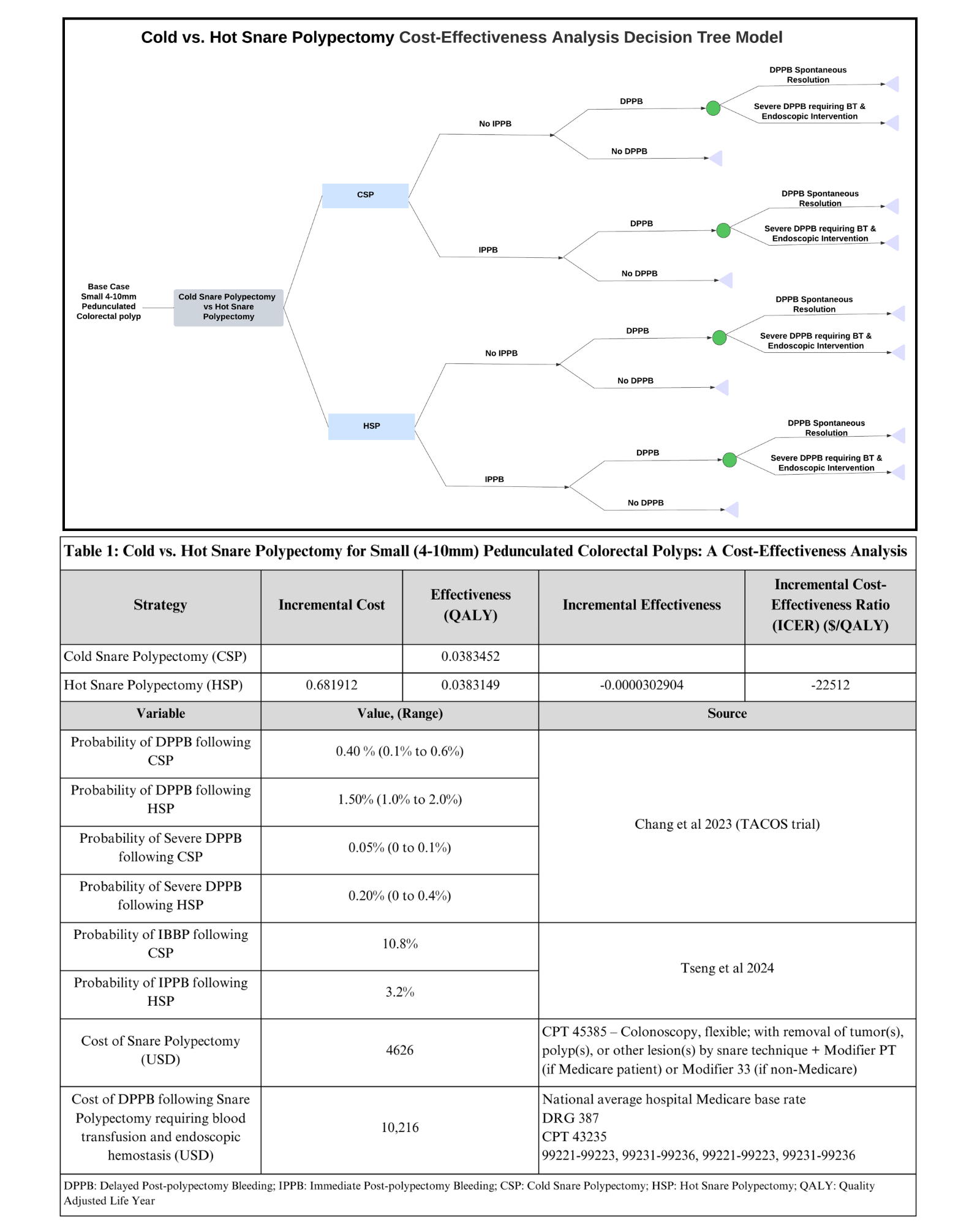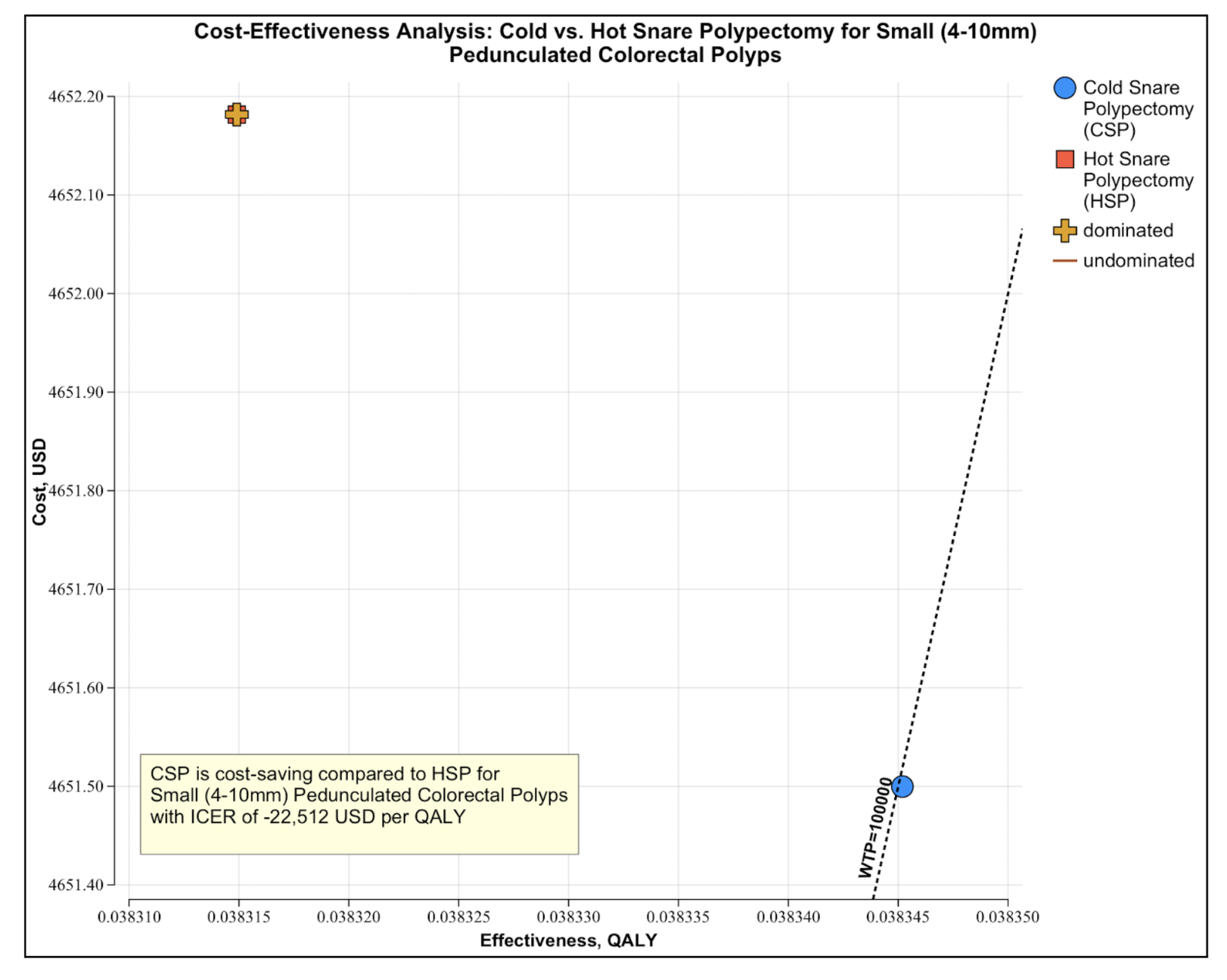Tuesday Poster Session
Category: Colon
P4555 - Cold vs Hot Snare Polypectomy for Small Pedunculated Colorectal Polyps: A Cost-Effectiveness Analysis
.jpg)
Sneh Sonaiya, MD, MPH, MBA
Kirk Kerkorian School of Medicine at the University of Nevada Las Vegas
Las Vegas, NV
Presenting Author(s)
1University of Nevada, Las Vegas, Las Vegas, NV; 2St. Mary Medical Center, Langhorne, PA; 3Mercy Catholic Medical Center, Darby, PA; 4Monmouth Medical Center, Long Branch, NJ; 5Kirk Kerkorian School of Medicine at the University of Nevada Las Vegas, Las Vegas, NV; 6Creighton University School of Medicine, Omaha, NE; 7Geisinger Health System, Danville, PA; 8Geisinger Health System, Danville, NJ; 9Orlando Gastroenterology PA, Orlando, FL
Introduction:
Several trials have supported the safety and efficacy of Cold Snare Polypectomy (CSP) compared to Hot Snare Polypectomy (HSP) for small colorectal polyps. Recent data suggest that compared to HSP, CSP is associated with a higher incidence of immediate post-polypectomy bleeding (IPPB). Nevertheless, CSP has demonstrated a significantly lower risk of delayed post-polypectomy bleeding (DPPB). Given these trade-offs, we evaluated the cost-effectiveness of CSP versus HSP for small (4-10mm) pedunculated colorectal polyps.
Methods:
We conducted an incremental cost-effectiveness analysis over a 2-week time horizon using a decision tree model informed by the Multicenter Randomized Taiwan Cold Polypectomy Study and relevant literature. Costs—including those for CSP, HSP, hemostatic clipping, colonoscopy, and hospitalization—were derived from CMS reimbursement data and published sources. Incremental Cost-Effectiveness Ratio (ICER) was determined for the base patient undergoing CSP vs HSP for small 4-10 mm colorectal polyps. Analysis was performed using TreeAge Pro Healthcare 2024.
Results:
IPPB was defined as perioperative bleeding requiring hemostatic clipping, while DPPB referred to bleeding within 2 weeks post-procedure, often necessitating transfusion and/or endoscopic intervention. Cost-effectiveness analysis included data from 4,270 patients (2,137 in CSP group; 2,133 in HSP group) for DPPB analysis and sub-group analysis of 647 patients with small 0-Ip polyp ≤10 mm (306 in CSP group; 341 in HSP group) for IPPB analysis. In the base case of a 61-year-old patient with small (4-10 mm) pedunculated colorectal polyps, CSP compared to HSP was associated with an incremental cost of $0.68, incremental effectiveness of -0.0000303 quality-adjusted life years (QALYs) and ICER of -$22,512 per QALY, indicating cost savings. Based on the one-way sensitivity analysis, CSP is cost-effective compared to HSP when (a) the cost of CSP is $4630 or less (b) probability of DPPB with CSP is ≤0.63% (c) probability of DPPB with HSP is ≥1.27%.
Discussion:
Considering the WTP threshold of $100,000 per QALY, CSP is a cost-saving procedure compared to HSP for small pedunculated colorectal polyps. Our study results suggest that although CSP has a higher risk of IPPB, its significantly lower risk of DPPB leads to considerable clinical and economic benefits. Given its cost savings and favorable risk profile, CSP should be considered the preferred technique for managing small pedunculated polyps.
Figure: Model Diagram and Model Inputs for the Cost-effectiveness analysis of Cold Snare Polypectomy versus Hot Snare Polypectomy for small (4-10mm) pedunculated colorectal polyps
Figure: Cost-effectiveness analysis of Cold Snare Polypectomy versus Hot Snare Polypectomy for small (4-10mm) pedunculated colorectal polyps
Disclosures:
Sneh Sonaiya indicated no relevant financial relationships.
Raj Patel indicated no relevant financial relationships.
Charmy Parikh indicated no relevant financial relationships.
Karan Yagnik indicated no relevant financial relationships.
Nicolas Alonso Barnechea Alvarado indicated no relevant financial relationships.
Magnus Chun indicated no relevant financial relationships.
Kyaw Min Tun indicated no relevant financial relationships.
Pranav Patel indicated no relevant financial relationships.
Harshit Khara indicated no relevant financial relationships.
Bradley Confer indicated no relevant financial relationships.
Vignan Manne indicated no relevant financial relationships.
Babu Mohan indicated no relevant financial relationships.
Sneh Sonaiya, MD, MPH, MBA1, Raj H. Patel, MD2, Charmy Parikh, MD3, Karan Yagnik, MD4, Nicolas Alonso Barnechea Alvarado, MD1, Magnus Chun, MD5, Kyaw Min Tun, DO6, Pranav Patel, MD7, Harshit S. Khara, MD8, Bradley D. Confer, DO7, Vignan Manne, MD5, Babu P. Mohan, MD9. P4555 - Cold vs Hot Snare Polypectomy for Small Pedunculated Colorectal Polyps: A Cost-Effectiveness Analysis, ACG 2025 Annual Scientific Meeting Abstracts. Phoenix, AZ: American College of Gastroenterology.
